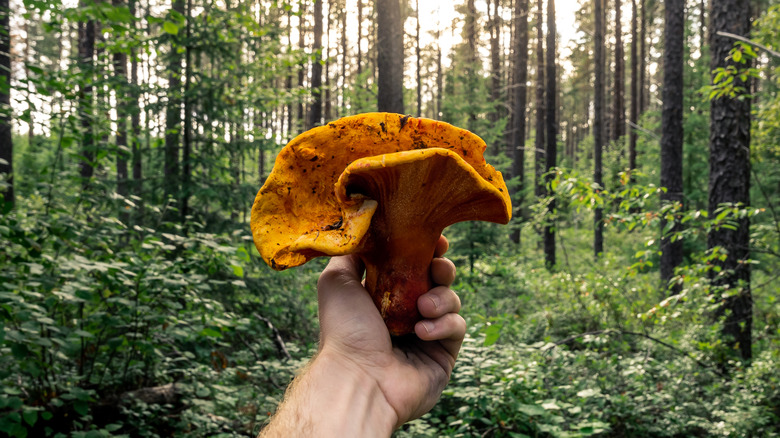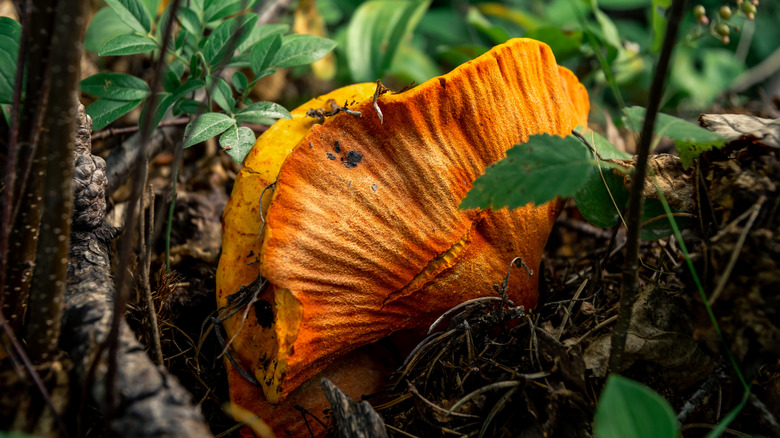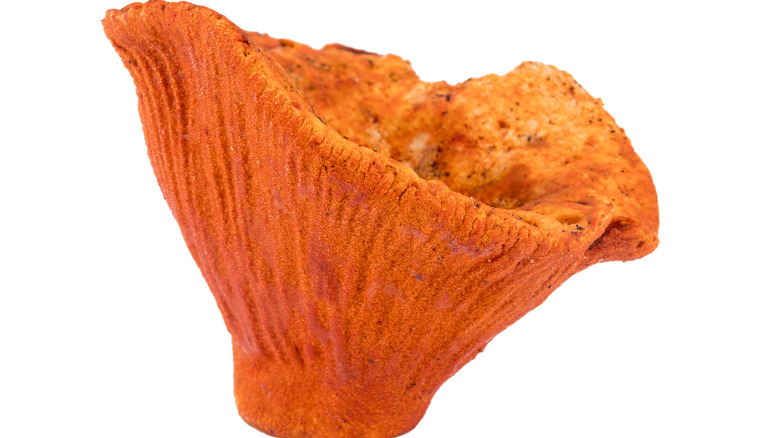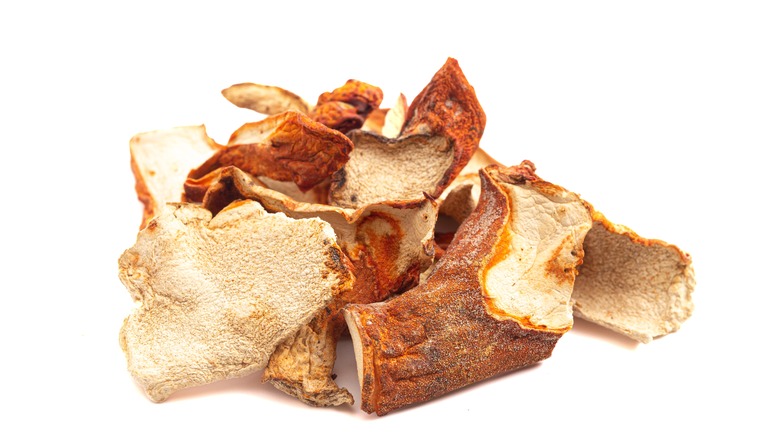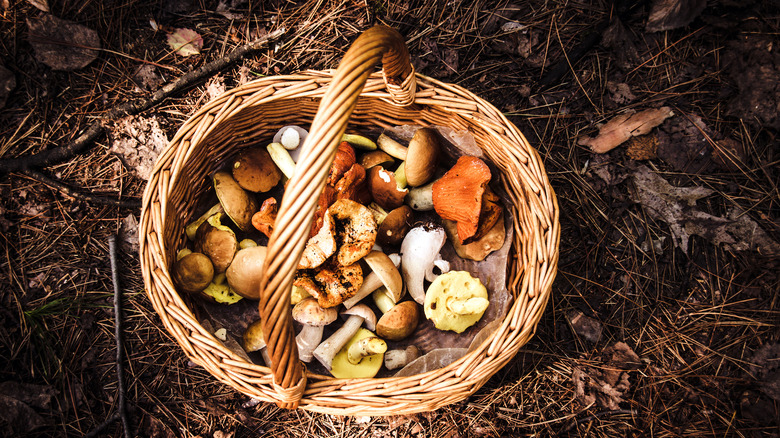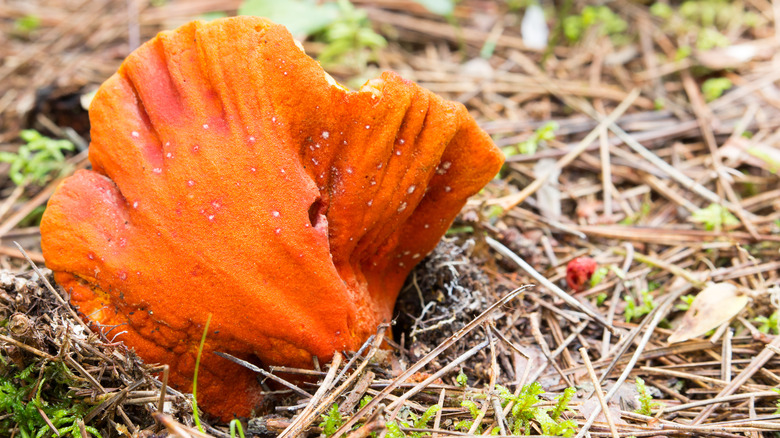What Are Lobster Mushrooms And Do They Taste Like Seafood?
The fungus is among us — whether it be the psychedelic, the medicinal, or the gourmet. From just chowing down to easing stress to fighting cancer (via Healthline), there's a mushroom out there for everything. In fact, edible varieties like the chanterelles and hedgehogs are seen as delicacies, while more common species such as portobellos and oyster mushrooms have become popular as meat substitutes in the plant-based community. It seems like mushrooms can do it all — but what if I told you that there was a mushroom out there that could replace your lobster?
It sounds almost unbelievable, but that's the magic of mushrooms. Commonly known as lobster mushrooms or, as they're known scientifically, Hypomyces lactifluorum (via Specialty Produce), the red, contorted fungi don't look like the cute, spotted mushroom emoji on your phone. With little to no stem, these mushrooms look more like a lobster claw — with a flavor and aroma to match.
How are lobster mushrooms made?
So how does a mushroom come to resemble a lobster? That all comes down to a parasitic fungus called Hypomyces, the Greek word for "mushroom underneath" (via Specialty Produce). According to Forager Chef, the fungus tends to prefer areas where their host mushrooms of choice — russula, white, milkcap, and Lactarius mushrooms — grow. When the fungus finds a host and begins to propagate, it literally alters the mushroom's chemical composition, covering it in a bright orange coating and contorting it into gnarled, odd shapes.
Not only do the mushrooms lose their stems, along with the gills underneath their caps in the process, but their taste and texture are completely transformed. Underneath their firm, vibrant orange-red caps is a white, dense, and sponge-like flesh. When sliced, they give off a seafood-like aroma — which Forage Chef claims can be linked to their iodine content. In turn, a mushroom that would've otherwise been flavorless is altered into a slightly nutty, earthy-tasting fungi, elevated by a faint flavor of shellfish and crustacean.
Due to this unique process, lobster mushrooms grow exclusively in the wild and not commercially.
White lobster mushrooms vs. red
While the stunning red lobster mushrooms are themselves considered delicacies, the white variety is even more so. Because of the parasitic fungi that lobster mushrooms often host, most of them will have vibrant reddish-orange skin with white marks and veins throughout. However, completely white lobster mushrooms, which lack these other features, also called ghost mushrooms (per Forager Chef), are a rare anomaly — and a delicious one, at that.
While they might look as if they haven't fully gone through the transformation instigated by the hypomyces fungus, the white ghost mushrooms are entirely safe to eat. But, still, they won't taste exactly the same as the more common red lobster mushroom. In fact, it is said that the white varieties have a slightly different aroma when they're freshly picked. Additionally, without the crisp red skin that develops with the hypomyces, ghost mushrooms have a much more tender texture.
Cooking with lobster mushrooms
When cooking with lobster mushrooms, Forager Chef recommends keeping it simple. You'll want to start by properly cleaning them, as lobster mushrooms tend to have a vase-like shape, they often serve as homes for a lot of things you don't want to eat. Begin with trimming the ends and brushing them clean — Specialty Produce specifies that you should use a dry brush to keep from removing their bright red/orange color. Once brushed, give your mushrooms a good shake to get off any of the debris that may be inside them. Then, cut out the middle and any soft spots.
Once they're cleaned and ready to cook, caramelization is key. To perfectly caramelize your mushrooms, A Sweet Alternative says to avoid using water to clean them, hence the dry brush, and not to cut them too thick. Using a large pan, add some olive oil or butter — because lobster mushrooms love fat — along with your cut-up mushrooms and a dash of salt. Then, sautée until all of the liquid has evaporated and your mushrooms are nicely golden in color. Finally, toss them with some herbs and garlic. You can eat the mushrooms or add them to pasta, chowder, soup, cream sauces, or stews.
Do note that their color will bleed into your food, similar to turmeric. They should also be eaten within a couple of days — that is, unless you choose to dry them and make a mushroom powder, which only amplifies their flavor.
Where to buy lobster mushrooms
Because lobster mushrooms aren't grown commercially, you're most likely to find them at your local farmers' market or a specialty grocer (per Specialty Produce). Depending on where you live, however, lobster mushrooms may be available at different times. For instance, Forager Chef claims that they are in season from mid-summer to September in the Midwest but last longer into the fall in the Pacific Northwest. Either way, if you see chanterelles appearing on the farmer's market stands, you can expect to find lobster mushrooms there next, as the fungi tend to grow in the same places as chanterelles — just earlier on in the season.
If you're not having any luck at the farmers market, however, you may want to take up the hobby of mushroom foraging for yourself — and, with their bright reddish-orange skin, and unique shape, lobster mushrooms are one of the easiest mushrooms for beginners to identify. Lobster mushrooms are found in areas with birch and other mixed woods, typically in the northern U.S. from the Pacific Northwest, New England, and Canada — although experts argue that they grow globally with different parasitic species. Nevertheless, they tend to grow in scattered groups, so if you find one, you're bound to find more nearby.
Nutritional information
Like its fellow fungi friends, reishi, lions mane, shiitake, and chaga (per Healthline), lobster mushrooms have some health benefits of their own. According to Specialty Produce, lobster mushrooms contain fiber — a macronutrient that a 2017 study published in the National Library of Medicine found that only one in 20 people get enough of. They also contain copper, which, according to Mount Sinai, your body needs in order to make energy, absorb iron, and make red blood cells, among other important bodily functions. However, they also contain small amounts of other vitamins, including vitamins B, D, and K, which contribute to the maintenance of your overall health.
That being said, lobster mushrooms aren't for everybody. For one, you must be really careful that you're cooking them within a week and eating them within a couple of days of cooking. Unlike chanterelles, eating old lobster mushrooms can make you very sick and lead to something called "mushroom poisoning" (via Forager Chef). You'll know they're safe to eat if they're firm and heavy feeling and without any purple coloring. People with shellfish and fish allergies should also be wary, as the iodine content in lobster mushrooms has been said to trigger sensitivities and mild allergy symptoms. To be safe, proceed with caution and sample small amounts of them.
